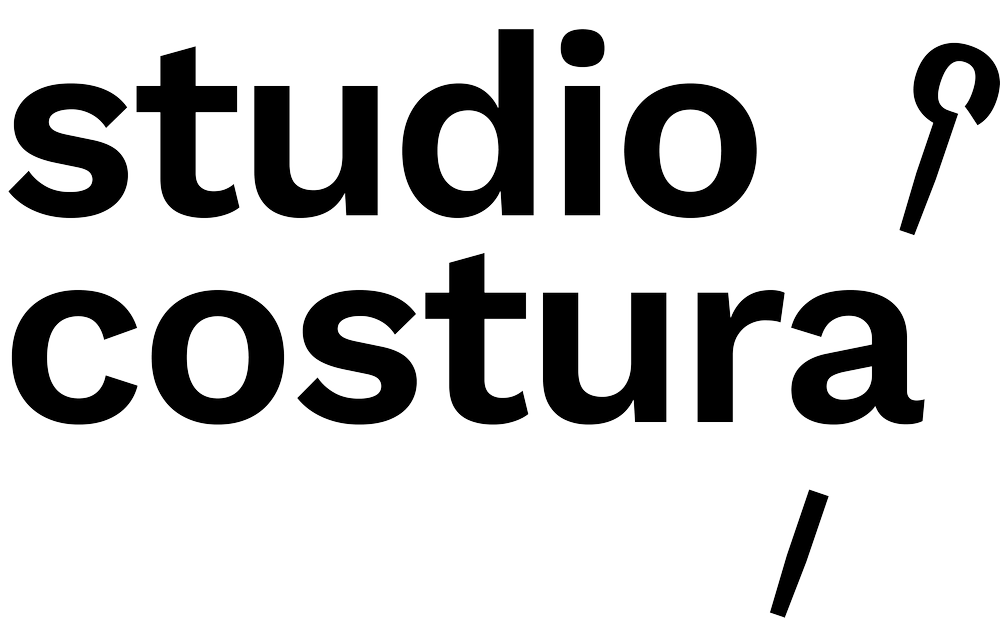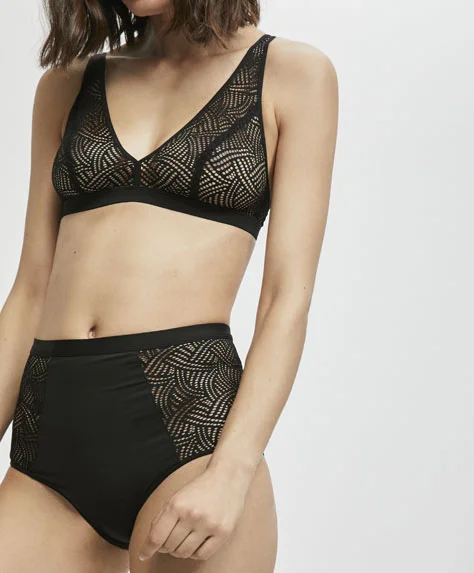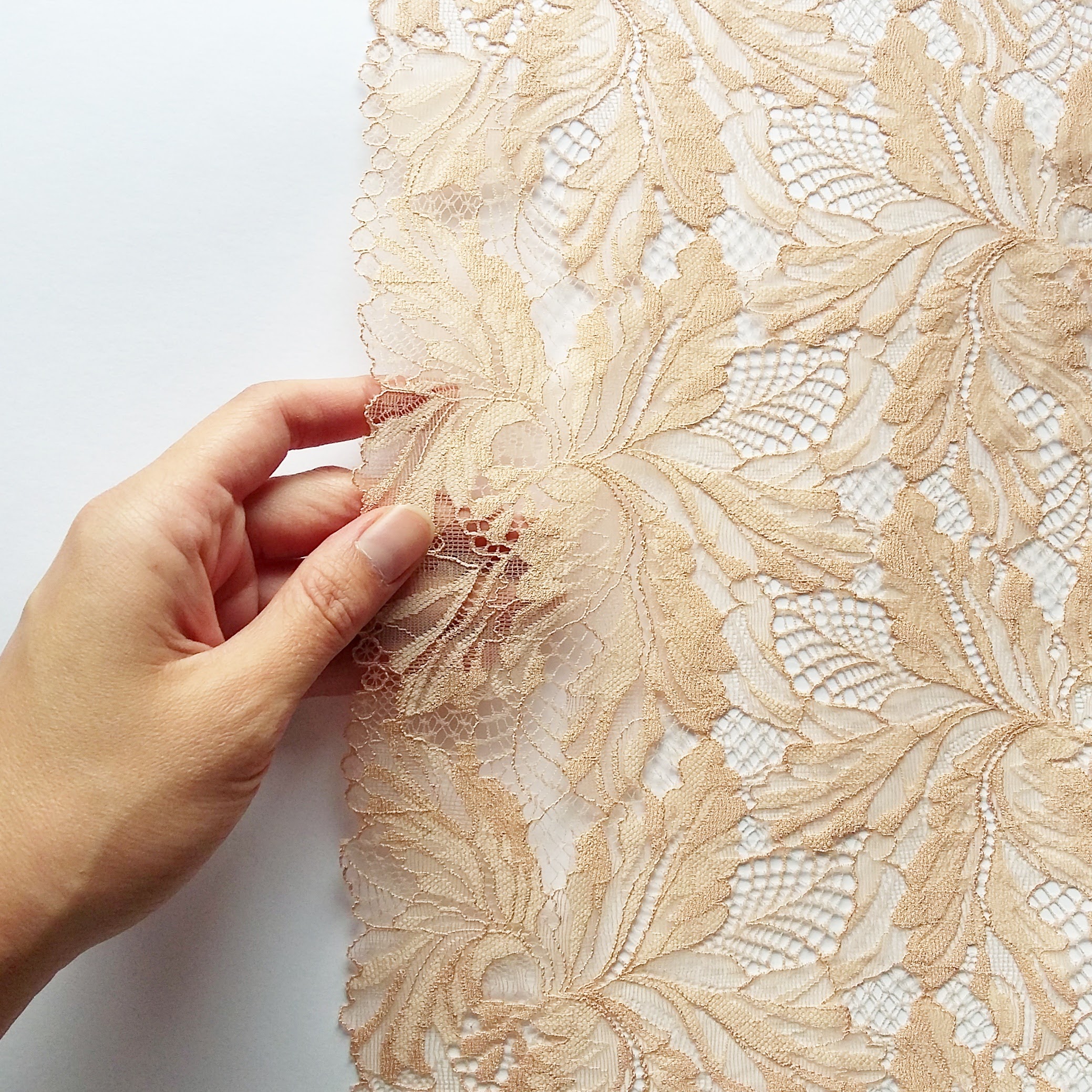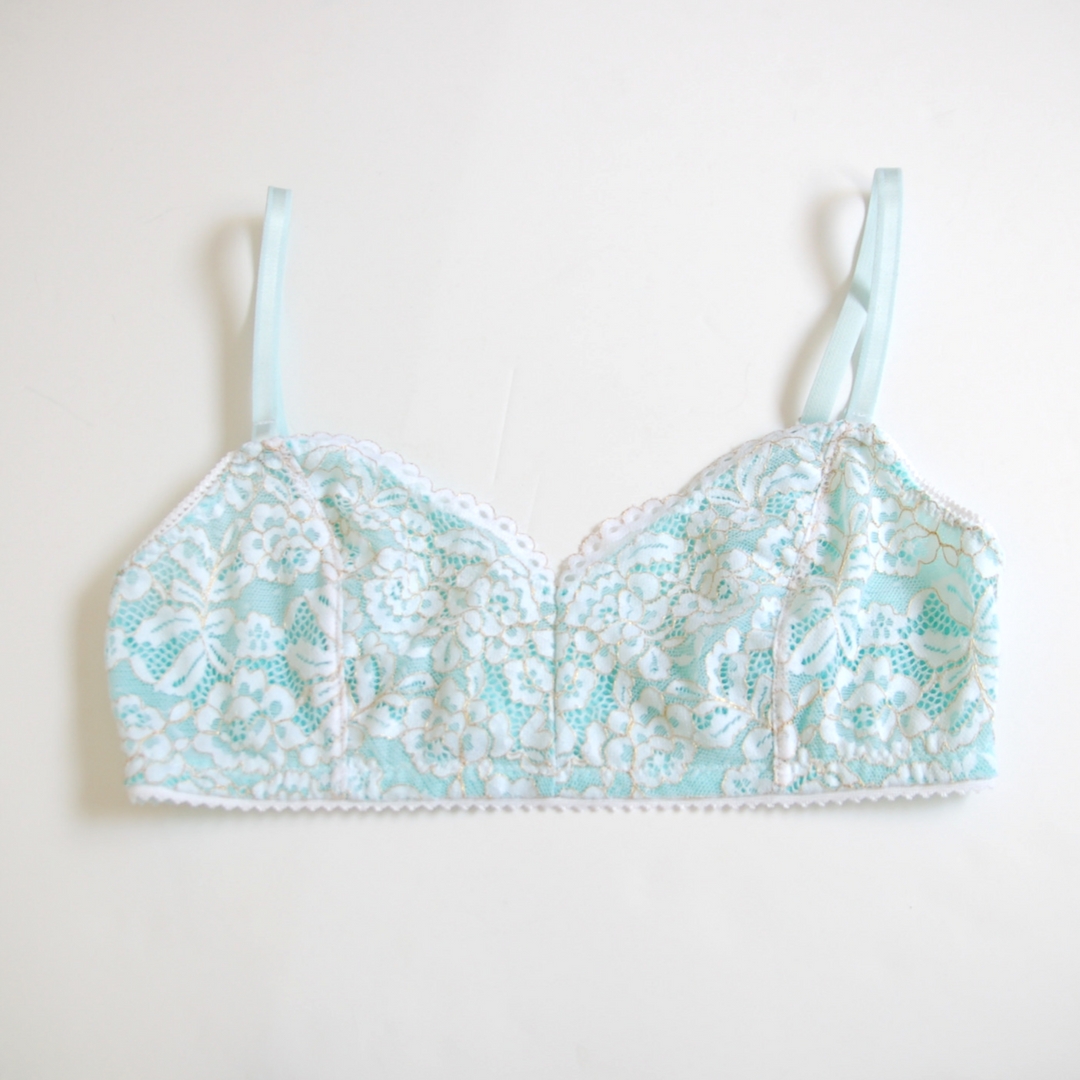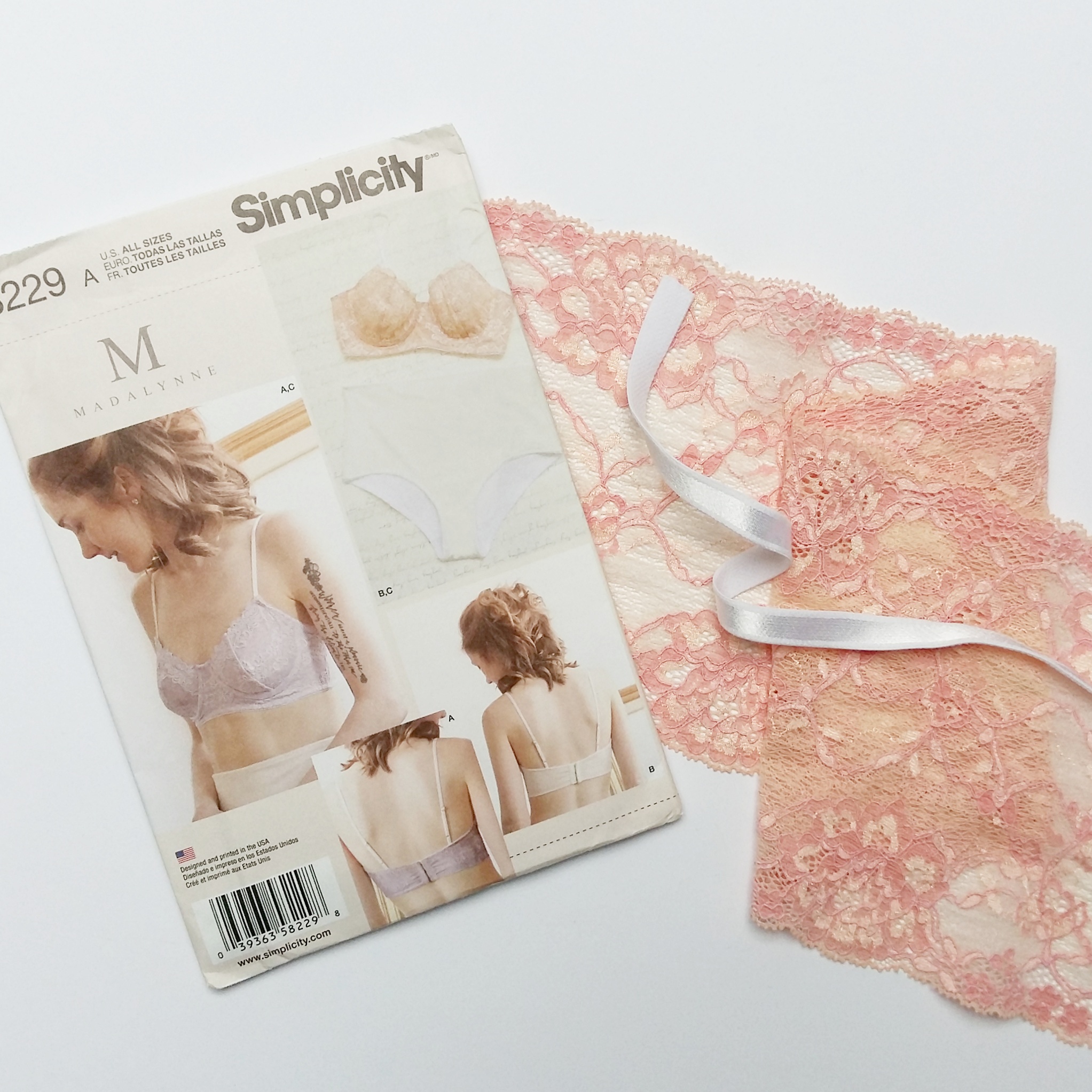Hola! Empezamos con el CoseConmigo para el patrón bralette Hanna. Primero quería agradecer a todo el mundo por el buen recibimiento de este patrón, me hace mucha ilusión compartir mi trabajo con vosotras y que os guste!
Hoy os enseño algunas fotos de bralettes con cortes similares que más me han gustado y espero que sean de inspiración para vuestros proyectos (todas las fotos son de Pinterest). Cada tela, encaje y color cambian tanto el aspecto de bralette así que lo podéis hacer totalmente a vuestro gusto. También voy a contaros un poco más sobre materiales que necesitáis para usar este patrón.
Hey! Today we're starting the sewalong for tha Hanna bralette pattern. First of all I wanted to thank you for all your support and nice words about this pattern, I'm really happy to share my work with all of you!
Today I'm sharing some photos of bralettes that have similar style lines as this pattern and I hope they will be an inspiration for your own sewing projects (all photos are from Pinterest). Every fabric, lace and color change so much the appearance of the bralette so you can really make it as you want. I will also tell you a bit more about supplies you need to sew with this pattern.
Hay encajes en tantos colores y formas, cada uno da un toque diferente y el resultado siempre es distinto. También mola mucho la combinación de telas de punto con puntillas elásticas.
There are laces in so many forms and colors, every one of them will give a distinct look for the final result. I also love the idea of combining knit fabrics with lace trims.
Usando distintos tipos de forros tendrás la posibilidad de hacer un bralette más transparente o al revés, dar más soporte donde tú lo prefieres. Aunque este patrón está hecho para encajes puedes probar también coserlo con telas de punto. Más adelante cuando termine este CC os voy a enseñar más muestras con telas y os daré trucos cómo coserlo.
Using different types of linings can change up the pattern a lot, you can make it transparent or the other way around, give it more support where you'd like to. Altough this pattern is made for lace you can also sew it using knit fabrics for the outside. Once I'll finish this sewalong I'll show you more versions with knits and I'll show you some tricks about sewing with them.
MATERIALES
ENCAJE
El patrón está diseñado para encajes elásticos y telas de punto. Lo ideal es que el encaje tenga por lo menos 50% de elasticidad. Si no sabes cuánto es el porcentaje del encaje (o de cualquier tela) es bastante fácil averiguarlo. Coge un trozo de 10 cm de encaje y estíralo hasta donde se da de sí y mide el resultado. Si puedes estirarlo hasta 14 cm tiene la elasticidad de 40 %, si es hasta 16 cm, sería de 60% etc. Según la elasticidad de cada tejido cambia la forma de cómo va a quedar la prenda. No hay formas correctas e incorrectas, tienes que experimentar y probar!
TELA DE PUNTO PARA EL FORRO
Para que el bralette sea cómodo se forra con tela de punto. Puedes usar diferentes tipos de telas de punto, de nuevo, su elasticidad va a cambiar el resultado (recomiendo por lo menos 50-60% de elasticidad en las telas de punto para este patrón). Yo prefiero usar punto de viscosa para el forro porque es finito, suave y no abulta y como es de origen natural también respira. Si quieres que tu bralette tenga más "forma" puedes usar punto de algodón más fuerte, lycras o incluso telas como neopreno ligero. En el siguiente post os hablaré cómo elegir la talla y hacer una prueba, cuando usas telas distintas tienes que probar si el cambio de elasticidad varia el resultado. Los puntos que tienen la elasticidad en dos direcciones suelen ajustarse mejor que los que solo tienen elasticidad en una dirección pero todo es cuestión de probar!
Si quieres que el bralette sea más finito y con más transparencias lo puedes forrar con tul elástico o dejarlo sin forro, allí ya son preferencias de cada una. También puedes usar tela de punto para la copa y tul para la banda.
Lo que os quiero decir es que el tema de las telas es todo un mundo. Ahora se venden todo tipo de telas de punto y tú tienes que ir probando qué es lo que más te gusta. No recomiendo puntos gruesos porque tendrás que coser los elásticos doblandolos encima del encaje y la tela...si el conjunto de todo esto es demasiado grueso tu máquina te puede dar problemas.
SUPPLIES
LACE
This pattern is designed for stretch lace and knit fabrics. The ideal lace would have aprox 50% stretch. If you don't know the stretch percentage of your lace (or any fabric in that case) you can easily calculate it. Pick a 10 cm long piece of lace and stretch it as long as you can, measure the result. If it measures 14 cm, it would have 40% of stretch, if it measures 16 cm, it would be 60% of stretch etc. Every knit fabric and lace will change slightly the final result. There are no correct or incorrect ways, you just need to experiement and try them out!
KNIT FABRICS FOR THE LININIG
To make the bralette extra comfortable it has a knit fabric lining. You can use different types of knits, again their elasticity will vary the result of the garment (I recommend knits with 50-60% stretch for this pattern). I prefer viscose knits for the lining as they are light weight, soft and not too bulky and they are also breathable. If you wish to have more support you can use stronger cotton knits, lycras or even lighter scuba knits. In my next post I will guide you more about choosing the size and how to make a muslin, using different types of knits really makes a difference there. The knits with a four-way stretch are usually more comfortable than the ones with a two-way stretch but it really depends so you can try it out!
If you'd like a more transparent result you can use stretch mesh for lining or you can even leave the lining out, it's a personal preferance. You can also use knits for the cup pieces and mesh for the band.
I just want to say that fabrics vary so much. You can buy so many different knits these days and you just have to experiment and see what's best for you. I don't recommend heavier knits as you have to apply the elastics later on and sewing trough double layer of bulky fabrics won't be easy on your domestic machine.
ELÁSTICOS
Para la lencería se usan elásticos específicos que suelen tener un lado suave (el que se queda contra la piel) y un lado decorativo que se ve (puedes leer este post en mi blog donde escribí más sobre los elásticos de lencería). En este patrón los margenes de costura están hechos para elásticos de 10 mm de ancho. Puedes usar en el bajo un elástico más ancho (tipo 15 mm) si quieres más soporte, lo que pasa es que tendrás que cambiar márgenes para no hacer el bralette más pequeño. Para la parte de la sisa podrías usar también un elástico más fino, de 7-10 mm, allí no necesitas tanto soporte (de nuevo si cambias el ancho de elástico tienes que modificar los margenes de costura). Básicamente puedes hacer pequeños cambios según los materiales que tengas o prefieras, yo puse el elástico de 10 mm en todo el bralette pensando en vosotras para que no tengáis que buscar muchos elásticos distintos y que la lista de los materiales sea lo más corta posible.
ELÁSTICO DE TIRANTE & LOS ARANDELAS Y LOS REGULADORES
El tirante que lleva este bralette es de 10 mm con sus arandelas y reguladores del mismo ancho. Si queréis podéis usar un tirante más ancho para más soporte (o más fino también), no hace falta hacer ningún cambio al patrón.
ELÁSTICO TRANSPARENTE
Este elástico que a veces también se llama la silicona lo usamos para estabilizar la parte del encaje que se queda vista en el escote. Así se asegura que el encaje no se da de si con tiempo y uso. Lo podéis obviar si hacéis tallas pequeñas pero yo sí que recomiendo usarlo.
ELASTICS
There are special lingerie making elastics used fo this purpose that usually have a plush back (the one that will be againts the skin) and a decorative edge (you can read this post on my blog where I wrote more about lingerie elastics). This pattern has seam allowances for 10 mm wide elastics. You could use a wider elastic (like 15 mm wide) for the bra band to have more support but you have to remember to change the seam allowances in order not to make your bralette too small. For the underarm area you could use also a narrower elastic (7-10 mm), you don't need so much support in that area (again you have to be careful with the seam allowances). Basically you can mix things up a bit acording to your own likes and depending on what materials you have in hand. I did include 10 mm elastics in the supply list as I wanted the list to be as small as possible so you don't have to go to look for too many supplies.
STRAP ELASTIC & RINGS AND SLIDERS
This bralette has a 10 mm strap elastic with the same width rings and sliders. If you'd like to use wider straps for more support (or narrower if you wish) you can perfectly do so, you don't need to change the pattern for this.
TRANSPARENT ELASTIC
This elastic also called sometimes as silicone elastic is used to stabilize the scalloped lace edge on the neckline. That way you make sure that the lace doesn't stretch out over the time. You can skip it if you are making a small size but I'd still recommend using it.
EL CIERRE
El patrón está pensado para un cierre de dos filas. No he puesto allí el ancho específico del cierre porque varian bastante según la tienda donde lo compres. Lo que quiero es que veáis bien las instrucciones o mejor aún comprobáis antes de empezar si vuestro cierre encaja bien con la pieza del patrón de la banda. El final de la banda (donde se cose el cierre) tiene que medir como el ancho del cierre + 2 veces el ancho de elástico que vas a usar. Comprueba si es así en el patrón y si resulta que debería estar más pequeño/grande puedes modificar el patrón antes de cortarlo. Voy a volver a recordar este paso cuando lo cosemos :)
Si quieres usar un cierre de tres filas lo puedes hacer, igual tienes que cambiar la parte de la banda para tener ese espacio allí.
Si quieres usar un kit específico para este patrón puedes comprarlo en mi tienda de Etsy elegiendo la opción "Hanna bralette kit" bajo todos los kits de la tienda. Si te gustaría cambiar algo en ese kit me puedes escribir allí en Etsy y te asesoro cómo hacerlo.
Otras tiendas para comprar materiales que te puedo recomendar son Tailor Made Shop (EE.UU.), Emerald Erin (Canadá) y B.Wear (Suecia).
THE CLOSURE
The pattern is drafted for a two row hook and eye set. I din't put the exact width of the closure on the list as they vary quite a lot depending on where you buy them. I just want you to read the instructions before cutting out your pieces to see if the hook and eye are suitable for the band piece. The end of the band has to measure the same as the hook height + two times the width of the elastics you are using. See if this is correct and if you need to make your band piece bigger/smaller you can just draft a new line there. I'll be talking about that step later on when we'll be at that stage of sewing too :)
You can use a three row hook and eye set you just have to change the pattern then.
If you'd like to use a specific kit for that pattern you can buy one at my Etsy shop. Choose the option "Hanna bralette kit" under any of the kits in the shop. If you'd like to change something in that kit you can write me at Etsy and I see what I can do.
Other places to buy lingerie making supplies are Tailor Made Shop (USA), Emerald Erin (Canda) and B.Wear (Sweden).
Pra terminar quería contestar a un par de preguntas que me habéis hecho sobre el patrón:
Puedo usar foam para coser este patrón?
En principio la respuesta es no porque el patrón es para telas elásticas y el foam en general no es elástica. No se quedaría igual el bralette. Pero...hay algunos trucos, por lo menos para las que tienen poco pecho, para poder adaptar este patrón para usar foam. Os hablaré de eso más adelante en otro tutorial.
Tengo mucho pecho, este bralette da buen soporte?
Hay que recordar que es un bralette y no un sujetador. El pecho grande lo que necesita es soporte de aros y materiales no elásticas, ninguna de las dos cosas están en este patrón. Este bralette está pensado para las copas A-C, sencillamente porque no da tanto soporte como un sujetador. Ahora, cada persona tiene sus preferencias y necesidades de confort...hay chicas con pecho grande que sí prefieren también usar este tipo de prendas por ejemplo más como sujetador de "andar por casa". Eso depende de tí, no te puedo asegurar que te vaya a gustar pero tampoco te voy a prohibir a que lo hagas :)
Sí que hay formas de hacer que este bralette "sujete" un poco más: usa una tela de punto para el forro más fuerte (lycra etc), elige un elástico más ancho para el bajo y para los tirantes y usa un cierre de tres filas.
Ok, eso es todo para hoy, lo siguiente será el tema de las tallas y cómo hacer una prueba antes de cortar el encaje. Si tenéis cualquier pregunta lo podéis poner en los comentarios!
To finish things off I wanted to answer some questions I've been asked about the pattern:
Can I use foam for this pattern?
The short answer is no as this pattern is drafted for stretch fabrics and foam in general is not stretchy. The bralette wouldn't fit the same. But...there are some tricks on how to use foam, well, at least for smaller cup sizes. I'll post a tutorial about that later on.
I have a big bust, will this bralette give enough support?
You need to remember that this is a bralette, not a bra. Bigger busts need support from wires and non stretchy stabilizing materials, none of them are part of this pattern. This bralette is recommended for cup sizes A-C, basically becuase it doesn't give so much support as a normal bra does. Then again every woman has their own preferencies and what might be comfortable for one might not be enough for someone else. There are women with big bust who use bralettes like this one as bras for "hanging around the house". I all depends on you, I can't say you'll love it but I also can't say don't do it :)
There are ways to make this bralette a bit more "supportive": use a stronger knit fabric for the lining (lycra etc), a wider elastic for the band and the straps and a three row hook and eye set.
Ok, that's it for today. The next post will be about sizing and making a muslin before cutting into lace. If you have any questions you can leave them in the comments section!
